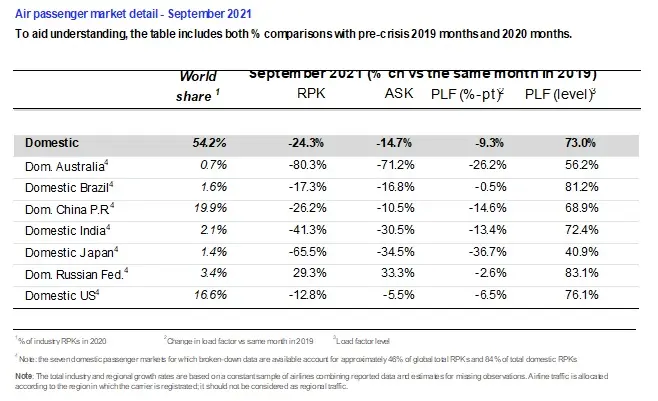(Geneva) - The International Air Transport Association (IATA) announced a moderate rebound in air travel in September 2021 compared to August’s performance. This was driven by recovery in domestic markets, in particular China, where some travel curbs were lifted following the COVID-19 outbreaks in August. International demand, meanwhile, slipped slightly compared to the previous month.
Because comparisons between 2021 and 2020 monthly results are distorted by the extraordinary impact of COVID-19, unless otherwise noted all comparisons are to September 2019, which followed a normal demand pattern.
- Total demand for air travel in September 2021 (measured in revenue passenger kilometers or RPKs) was down 53.4% compared to September 2019. This marked an uptick from August, when demand was 56.0% below August 2019 levels.
- Domestic markets were down 24.3% compared to September 2019, a significant improvement from August 2021, when traffic was down 32.6% versus two years ago. All markets showed improvement with the exception of Japan and Russia, although the latter remained in solid growth territory compared to 2019.
- International passenger demand in September was 69.2% below September 2019, fractionally worse than the 68.7% decline recorded in August.
“September’s performance is a positive development but recovery in international traffic remains stalled amid continuing border closures and quarantine mandates. The recent US policy change to reopen travel from 33 markets for fully vaccinated foreigners from 8 November is a welcome, if long overdue, development. Along with recent re-openings in other key markets like Australia, Argentina, Thailand, and Singapore this should give a boost to the large-scale restoration of the freedom to travel,” said Willie Walsh, IATA’s Director General.


International Passenger Markets
European carriers’ September international traffic declined 56.9% versus September 2019, down 1 percentage point compared to the 55.9% decrease in August versus the same month in 2019. Capacity dropped 46.3% and load factor fell 17.2 percentage points to 69.6%.
Asia-Pacific airlines saw their September international traffic fall 93.2% compared to September 2019, virtually unchanged from the 93.4% drop registered in August 2021 versus August 2019 as the region continues to have the strictest border control measures. Capacity dropped 85.2% and the load factor was down 42.3 percentage points to 36.2%, easily the lowest among regions.
Middle Eastern airlines had a 67.1% demand drop in September compared to September 2019, slightly improved over the 68.9% decrease in August, versus the same month in 2019. Capacity declined 52.6%, and load factor slipped 23.1 percentage points to 52.2%.
North American carriers experienced a 61.0% traffic drop in September versus the 2019 period, somewhat improved on the 59.3% decline in August compared to August 2019. Capacity dropped 47.6%, and load factor fell 21.3 percentage points to 61.9%.
Latin American airlines saw a 61.3% drop in September traffic, compared to the same month in 2019, an upturn over the 62.6% decline in August compared to August 2019. September capacity fell 55.6% and load factor dropped 10.7 percentage points to 72.0%, which was the highest load factor among the regions for the 12th consecutive month.
African airlines’ traffic fell 62.2% in September versus two years’ ago, almost 4 percentage points worse than the 58.5% decline in August compared to August 2019. September capacity was down 49.3% and load factor declined 18.4 percentage points to 53.7%.
Domestic Passenger Markets


Brazil’s domestic market sustained its gradual recovery amid positive vaccination progress. Traffic was down 17.3% compared to September 2019 – improved from a 20.7% fall in August.
Japan’s September domestic traffic was down 65.5%, worsened from a 59.2% decline in August versus August 2019, owing to the impact of restrictions.
The Bottom Line
“Each re-opening announcement seems to come with similar but different rules. We cannot let the recovery get bogged down in complication. The ICAO High Level Conference on COVID-19 agreed that harmonization should be a priority. The G20 declared a commitment to take action to support a recovery with seamless travel, sustainability, and digitalization. Now governments must put actions behind these words to realize simple and effective measures. People, jobs, businesses and economies are counting on real progress,” said Walsh.
IATA’s vision for safely re-establishing global connectivity is based on five key principles:
- Vaccines should be available to all as quickly as possible
- Vaccinated travelers should not face any barriers to travel
- Testing should enable those without access to vaccines to travel without quarantine
- Antigen tests are the key to cost-effective and convenient testing regimes, and
- Governments should pay for testing, so it does not become an economic barrier to travel
View the full September Air Passenger Market Analysis, (including 2021 vs. 2020 comparisons)
View the COVID-19 September 2021 traffic data presentation
-Ends-
For more information, please contact:
Corporate Communications
Tel: +41 22 770 2967
Email: corpcomms@iata.org
- IATA (International Air Transport Association) represents some 290 airlines comprising 83% of global air traffic.
- You can follow us at https://twitter.com/iata for announcements, policy positions, and other useful industry information.
- Statistics compiled by IATA Economics using direct airline reporting complemented by estimates, including the use of FlightRadar24 data provided under license.
- All figures are provisional and represent total reporting at time of publication plus estimates for missing data. Historic figures are subject to revision.
- Domestic RPKs accounted for about 54.3% of the total market.
- Explanation of measurement terms:
- RPK: Revenue Passenger Kilometers measures actual passenger traffic
- ASK: Available Seat Kilometers measures available passenger capacity
- PLF: Passenger Load Factor is % of ASKs used.
- IATA statistics cover international and domestic scheduled air traffic for IATA member and non-member airlines.
- In 2020, total passenger traffic market shares by region of carriers in terms of RPK were: Asia-Pacific 38.6%, Europe 23.7%, North America 22.7%, Middle East 7.4%, Latin America 5.7%, and Africa 1.9%.
© Press Release 2021
Disclaimer: The contents of this press release was provided from an external third party provider. This website is not responsible for, and does not control, such external content. This content is provided on an “as is” and “as available” basis and has not been edited in any way. Neither this website nor our affiliates guarantee the accuracy of or endorse the views or opinions expressed in this press release.
The press release is provided for informational purposes only. The content does not provide tax, legal or investment advice or opinion regarding the suitability, value or profitability of any particular security, portfolio or investment strategy. Neither this website nor our affiliates shall be liable for any errors or inaccuracies in the content, or for any actions taken by you in reliance thereon. You expressly agree that your use of the information within this article is at your sole risk.
To the fullest extent permitted by applicable law, this website, its parent company, its subsidiaries, its affiliates and the respective shareholders, directors, officers, employees, agents, advertisers, content providers and licensors will not be liable (jointly or severally) to you for any direct, indirect, consequential, special, incidental, punitive or exemplary damages, including without limitation, lost profits, lost savings and lost revenues, whether in negligence, tort, contract or any other theory of liability, even if the parties have been advised of the possibility or could have foreseen any such damages.



















